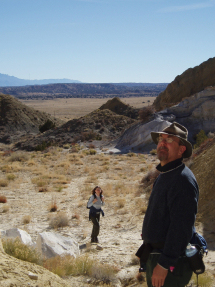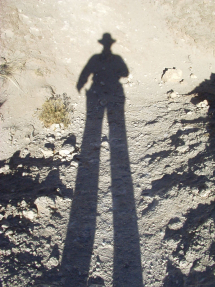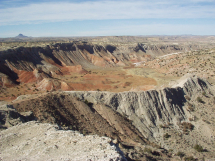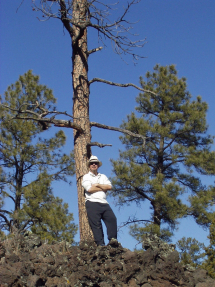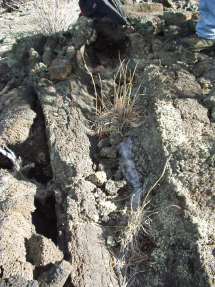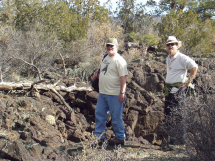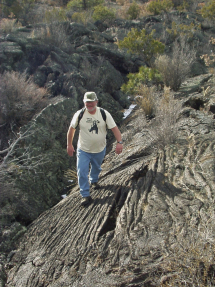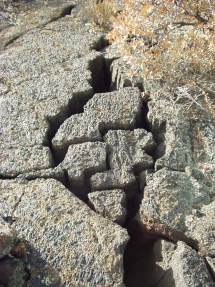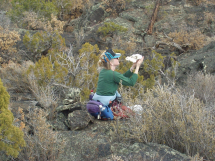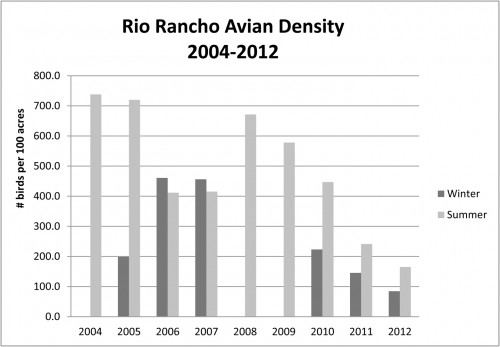Another occasion in the wilderness with James, this time with the family in Ojito Wilderness, northwest of Albuquerque, New Mexico. Starkly beautiful.
Category Archives: daytrips
Hiking the Zuni-Acoma Trail in El Malpais
We did this in 2003 — 20 years ago!
Acoma Pueblo Sky City
Albuquerque Journal | Acoma families inhabit Sky City live a lifestyle that’s millennia old, and share the ancient story of the pueblo with visitors By Glen Rosales / Journal Staff Writer, Sunday, October 25th, 2015 at 12:02am
Sitting high atop a mesa, commanding a view of the surrounding countryside, Acoma Pueblo has been a bastion for the Native Americans of the area for hundreds of years.
In fact, it’s the oldest continuously inhabited community in the United States, dating back to about 100 A.D., with some of the current adobe dwellings more than 400 years old.
And it’s also one of the most accessible of the pueblos as Acoma not only encourages visitors, but makes it an easy endeavor with guided tours, acomaskycity.org, said Melvin Juanico, group tour director for the pueblo.
New Mexico’s top 10 national and state parks | Travel | The Guardian
Nice one-page article with photos. We haven’t seen all of these, but most.
New Mexico’s top 10 national and state parks | Travel | The Guardian Mary Caperton Morton
New Mexico lives up to its nickname – the Land of Enchantment – with glittering deserts, vast underground caverns, gem-rich mountains and hundreds of years of human history
New Mexico’s top 10 national and state parks | Travel | The Guardian
Fall for a walk | Albuquerque Journal News
A description of several nice trails in or near Abq.
The cooler temperatures of fall make it a great time to spend some quality time outdoors. But the shorter days also mean weekday outdoor time probably has to be close to home.
Fortunately, the Albuquerque area has many great trails (both urban and forest) where you can enjoy the weather, get some great views and get in some exercise if you’re so inclined. Only the trail on the east side of the Sandias takes more than 30 minutes to get to. And all are uniquely Albuquerque.
Why can’t we take the Crane Train to Bosque del Apache?
Imagine boarding the Rail Runner in Santa Fe or Albuquerque and riding south to Bosque del Apache. Wouldn’t it be fantastic? We have the tracks, we have the trains, we have the natural attraction. More than anything we lack imagination and determination to make it happen.
The people most likely to take this train don’t require a fancy stop. The Durango-Silverton rail simply stops in the middle of wilderness for hikers.
Eventually, I’d like to see a special Crane engine modeled after the lovely Rail Runner. But we could start this run in no time. We have trains going to the Wine Festival in Bernalillo. Why not to the Festival of the Cranes?
[reposted from 10/23/13 every year until we can do this]
Cumbres and Toltec, the Chama train
Nice photos and a great overview of the Chama train, the Cumbres and Toltec, a very popular day trip on the border of New Mexico and Colorado. Beautiful country.
The State Bar Albuquerque Journal Center green space is gorgeous
It has taken me years to finally visit this area I have driven by countless times. This pleasant spring afternoon, people walked among the buildings and played frisbee over the arroyo, while a class of young students sat in grass under a spreading tree.The landscaping and surrounding architecture make this a fabulous walk in the middle of the city with amazing views of the Sandias. This is also a birding hotspot, though not on the occasion of my first visit.
I applaud the architects, planners, and builders for this area. However, it was a terrible mistake to allow the AC systems on the back of the building adjacent to this space — those should be on the roof. This adds unnecessary noise to an area that already suffers from the adjacent Interstate. (Perhaps this should be a requirement of zoning codes.) The smoking area behind one of these building should also be moved — gag, people, take a walk and stop killing yourselves and the rest of us.
See all 11 photos in album format.
We know “improving access” to the Bosque hurts it
Protect our Bosque from the Proposed Rio Grande Vision Plan / Hawks Aloft Inc.
Hawks Aloft Blog
Protect our Bosque from the Proposed Rio Grande Vision Plan
September 4th, 2013
It is not often that we, at Hawks Aloft, take on an activist role in our community. However, we have relatively recently become familiar with the details of the Rio Grande Vision Plan, proposed by Mayor Berry and his design team. That site was updated only yesterday, therefore considerable detail has not yet been reviewed. There is a public meeting tonight
Wednesday Sept. 4, 6 -8 pm
Albuquerque Museum
2000 Mountain NW
Albuquerque NM 87104There will be a second public meeting on Wednesday Sept. 18, 6 -8 pm.
We encourage you to familiarize yourself with the plan, attend the meetings and express your opinions, either through the public meeting venue or by submitting written comments to via email to theplan@cabq.gov Comments may also be mailed to The Mayor’s Office, PO Box 1293, Albuquerque NM 87103.
As an organization that cares deeply about the health of our bosque, we mailed a letter to the Mayor on September 3, 2013, the same date as the revised Plan was posted on the City website. We urged Mayor Berry and his team to consider the effects of a similar management that has occurred in the Rio Rancho bosque over the past 10 years and the devastating impacts to bird densities as that reach of the bosque has become more ubanized. A full copy of our letter to the Mayor follows below this chart.
Rio Rancho bosque Avian Densities 2003-2012
September 3, 2013
Mayor Richard Berry
City of Albuquerque
PO Box 1293
Albuquerque, NM 87103Hawks Aloft, Inc. is deeply concerned that the City of Albuquerque’s Rio Grande Vision Plan, if enacted, will have a devastating effect on avifauna and other wildlife that depend on the natural habitat of the bosque. We base our concerns on scientific data collected by Hawks Aloft, Inc. We have conducted avian monitoring within the bosque, between Bernalillo and the La Joya Game Management Area since December 2003. The purpose of our study is to assess avian abundance and species richness (number of different species observed) relative to habitat and management entities. We currently monitor 78 (½ mile long) transects in various habitats. Each route is surveyed three times per month during the summer and winter months, when the birds present are resident, rather than migratory.
As greater detail has been released about the Rio Grande Vision Plan, it is apparent that large portions of the bosque within the Rio Grande Valley State Park will be developed to increase human usage, with hardened riverside trails up to as 8-10’ wide, viewing blinds, benches, and other park-like amenities, many of which are proposed for installation along the river’s edge. The Plan also calls for removal of non-native vegetation as part of a restoration process. All of these sound very similar to the Willow Creek bosque management that has occurred in our neighbor to the north, Rio Rancho.
The Rio Rancho bosque has undergone significant changes, from an unmanaged wild area in 2003 to urban parkland between 2004 and 2012. (Changes have occurred in 2013, but data are still being analyzed). We have documented a significant decline in avian abundance over time as this section of bosque has become increasingly developed.
We provide the history below as potential explanation for the change in bird densities in the Rio Rancho bosque.
2004-2005: Mechanical clearing of non-native woody vegetation occurred in some areas. Sunflower crop was poor, resulting in relatively low bird numbers during winter. Limited human use.
2006-2007: Vegetation re-growth and presence of extensive sunflower patches. The sunflowers attracted large numbers of wintering birds, especially sparrows and finches.
2008-2009: Crusher-fine loop trail installed. Human use began increasing as soon as trail was completed. No winter surveys conducted due to lack of funds.
2009-2010: Clearing resumed, again using heavy equipment, resulting in removal of all woody vegetation except for coyote willow, cottonwoods, and a few, scattered New Mexico olives. Expanded wide, crusher-fine, walking trails, and smaller trails with classroom style seating. Sunflowers were mowed prior to setting seed.
2011-2012: Avian density among the lowest of all transects surveyed.
2013: Additional crusher-fine trails and benches installed. Riverbed altered to shift water flow closer to the Rio Rancho bosque and provide benefit to silvery minnow. Fill from riverbed mounded on west edge. Fill area seeded; minimal planting of shrubs.
Human and dog use of the Willow Creek bosque has grown exponentially since the establishment of the wide, crusher-fine trail. It is not unusual to encounter 20-30 people and up to 10 dogs, many of them off-leash, during a ½ mile long transect. This bosque has become a place for people and a de facto dog park, with little natural habitat for wildlife. Birds that utilize the shrub understory and ground dwelling species have largely disappeared due to the lack of cover and persecution by unleashed dogs. Those birds present are largely canopy dwelling species such as White-breasted Nuthatch, Downy Woodpecker, House Finch, and Black-chinned Hummingbird.
All Russian olive (non-native) and junipers (native) have been removed from the Willow Creek bosque. Russian olive is of vital importance to birds in the middle Rio Grande bosque. It is, in general, greatly undervalued by land managers, but provides important nesting substrate for sub-canopy and understory breeding birds as well as an important food and cover resource. While dense stands of coyote willow provide valuable cover for birds, they do not provide a substantial food resource, particularly for seed and berry eating animals; additionally, because coyote willow lacks a complex structure, it is of limited value to nesting birds.
We believe that the Rio Grande Vision Plan, if enacted in its current state, will have a similar, equally devastating effect on bird numbers, as that documented in the Rio Rancho bosque. We sincerely hope that we are able to have a voice at future technical science team meetings. It seems rather odd that the research group that has monitored bird use in the bosque for the past 10 years has not been included in the planning process. Thank you for your attention to our concerns.
Protect our Bosque from the Proposed Rio Grande Vision Plan / Hawks Aloft Inc.
“Some people say we have loved the canyon to death, but I wouldn’t call it love.” — Thom Cole
As I wrote in This forest doesn’t know it’s dead.
» Beloved river canyon in bull’s-eye | ABQ Journal by Thom Cole
But it’s been years since I’ve fished in the Pecos Canyon, in large part because of the crowds and the damage that has been caused to the canyon. Some people say we have loved the canyon to death, but I wouldn’t call it love.
Both the U.S. Forest Service and the state Department of Game and Fish manage recreation sites in the canyon, and a 2008 report prepared by the Forest Service painted a grim picture.
Among the problems cited by the report: too many vehicles, campgrounds in poor condition, violence, trash, alcohol abuse, rowdy campers, stream bank erosion and collapse, and off-road and even in-river vehicle use.
A couple years ago, I volunteered with schoolchildren and others to help pick up trash at Monastery Lake, and in and around the Terrero Campground. Lots of beer cans and bottles, a hypodermic needle, fishing line, toilet paper, human waste, clothes and more.
I visited Monastery Lake a few weeks after the cleanup, and it was if we had never been there. Just last spring, Forest Service sites that hadn’t opened yet were littered with trash and human waste.
Rio Grande Vision- Nature center or amusement park? – New Mexico Mercury #abqbosque
The redoubtable V.B. Price joins the chorus against Mayor Berry’s “Vision Plan†for our treasured bosque, a thin ribbon of green between desert and river, the largest vestige of a riparian habitat that used to flank the entire Rio Grande. I think Price makes a good point about how the plan ignores the Nature Center (which is showing its age) while the plan tips its hat to urban development in other locales. His reference to Elena Gallegos overlooks the development there, which seems to work. We might also compare the rough-hewn trails of the foothills and crest with the ski area and tram. Who opposes those? The bike trail and trailhead parking at Alameda are all the development I want or need. peace, mjh
What’s happened to ABQ? Part 5: Rio Grande Vision- Nature center or amusement park? – New Mexico Mercury By V.B. Price
Modeling itself on duded up urban rivers in Texas and other places, the Vision seems to have overlooked completely the ideal model right under its nose – the Rio Grande Nature Center, a masterwork of architecture so inconspicuous and respectful of its place that birds and other creatures have no fear of us when we’re visiting. …
Albuquerque Mayor Richard Berry’s Rio Grande Vision Plan is a complete contradiction of the long range vision of the people who battled and struggled for decades to preserve the Bosque as a wild place in the middle of the city that could teach us all that we live in a fragile natural world that needs to be cared for and conserved, rather than exploited as a resource. That battle was part of the Open Space movement that preserved our volcanoes, most of the Sandias, and many wonderful spaces like the Ellena Gallegos Open Space. No one would dare suggest viewing platforms, cafes, and the like in such pristine spaces. The Bosque, for all its human presence, is the same kind of place. The symbol of that founding open space vision of the Bosque is one of Albuquerque’s great works of architecture — the much praised and awarded Rio Grande Nature Center, designed by Albuquerque’s Antoine Predock, FAIA, and completed in l982. …
The Bosque doesn’t need improvement. It needs love, respect, and attentive care. It’s stressed enough by climate change as it is. It’s doesn’t need us to burden it further.
Why I changed my mind to favor paving the north road into Chaco
I’ve driven to Chaco Canyon, the Anasazi heartland in northwest New Mexico, every year for nearly 30 years, sometimes more than once per year. I have driven in and out every available route, including the long-since closed old north road that wound down past Casa Chiquita. Overall, I prefer to drive in from the south via Grants and Milan (at least, until Peabody Energy destroyed that area). I like the old south road in, as rugged as it can be. In contrast, the new south road via Pueblo Pintado is out of the way, connecting to the north road before the worst of that stretch. When I come in via the south, I go out north along the road that may be the major route for travelers.
If you haven’t been to Chaco, there is much you may not be able to fully imagine. It’s remote. It’s largely desolate. It’s well-worth almost any journey. Like many of the Chaco faithful, I have opposed paving the final stretch of the north road. I felt this is a pilgrimage and need not be easy. I was surprised after all these year to change my mind about this.
[from my journal at the time]
I made coffee and ate lunch of cheese and crackers. I dropped the camper roof and stowed everything. By 12:15pm, I was ready to roll.
And roll, I did. When I left pavement at the park boundary, the entire vehicle shook violently. Suddenly, the dash was beeping and flashing. It was only the alarm for the passenger seat belt, set off by the weight of my gear and the shaking. I slowed to 15mph for much of the next 15 miles — do the math. During that stretch, I reconsidered the issue of whether to pave the road in. I think the old South road should remain wild and primitive, but now, I think the north road should be paved. Why should every person who visits Chaco have a miserable trip in and out again? That’s not a right of passage, that’s abuse. If the real concern is a flood of visitors, then regulate the size of vehicles or the number of passengers entering Chaco at one time. Limit touring companies, if they become an issue. Why should we all suffer time and again? So long as I can chose to suffer and enjoy the old South Road now and then. …
It’s weird to go from foot pace to 65 miles per hour in such a short time. To go from a teeth jarring road to smooth asphalt. To accelerate into the modern world from the ancient and ageless.
The old south road should never be closed nor improved. Never. But, I’m ready for pavement to the north, back to the place we came from.
Visit my Chaco page for more text and photos.
Chaco: Seen and Unseen – New Mexico Mercury
I recommend the essay and photos by Margaret Randall, a New Mexico treasure herself.
Chaco: Seen and Unseen – New Mexico Mercury
By Margaret Randall – International Raconteur
(Photos by Margaret Randall) At Chaco Culture National Historic Park much is apparent but much remains hidden. The place hides as many secrets as it reveals. What one sees is breathtaking. What one cannot see but only feel, also awes the spirit. A vast solitude describes the landscape: once probably greener and more sustaining of life, today dramatically desolate, a mystery only partially unfolding….
» Proposed city development would threaten river park | ABQ Journal #abqbosque
Our bosque is a treasure but one easily destroyed by good intentions.
» Proposed city development would threaten river park | ABQ Journal by Dave Parsons
Few American cities can boast such a magnificent natural amenity. Many cities have invested millions of dollars to recreate “green belts.†In Albuquerque, all we have to do is protect what we already have.
However, now, following a century of protection, the natural beauty and ecological integrity of the Rio Grande Valley State Park is being threatened by the Rio Grande Vision – a bosque development plan promoted by Mayor Richard Berry.
The Rio Grande Vision is a disturbing departure from the purposes set forth by the state’s legislation and the Bosque Action Plan. It starts us down a path of incrementally destroying the natural and ecological integrity of the bosque through ill-defined development.
» Proposed city development would threaten river park | ABQ Journal





